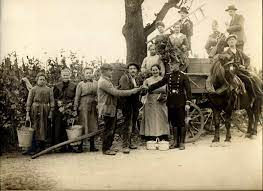
Comparison - Jeanne Arens
The wine history of Krems and the wine history of Luxembourg
Krems, a small Austrian town located at the Danube, is known for its various white wines. The city has a very old history and was first mentioned in 995 AC. Therefore, unsuprisingly the first mention of wine in Krems dates from the third century after AC. In the 11th century, the “Kremser Sandgrube“ is mentioned the first time and has become known for it's “Grüner Veltliner”, the most popular white wine.
As Krems became more populated, over 40 monasteries have owned valuable vineyards in Krems and the surrounding area.
The winegrowers’ guild fromed in Krems in 1447, which has a sole ownership of approximately 900 member winegrowers, is the oldest one in the German-speaking region and is considered quite prestigious. In the hight of viticulture, social, ecclesiastical, and secular gatherings of all classes led to an intensive and highly cultivated, urban community life.
Today, wine is still very popular and still a precious beverage in the region in and around Krems.
Luxembourg is a small country between France and Germany with a rich wine history. The Moselle region, where I live, is the region in which the wine is cultivated. The Moselle is a river that forms the border with Germany over a length of 36 kilometers which divides the wine growing regions of Luxembourg and Germany. Throughout the area, the Romans introduced viticulture as early as the 1st century BC. In the Middle Ages, viticulture boomed due to the foundation of many monasteries. The most popular wines from this region are “Pinot Gris” and “Riesling”. Due to a freezing winter in 1709, the vineyards were almost destroyed. After the decision of the Congress of Vienna in 1815, the Grand Duchy of Luxembourg had to concede all the vineyards on the other side of the river. In 1880 the "Les Domaines de Vinsmoselle", an association of six winegrowers' cooperatives with 450 grape suppliers, was formed which lead to the increasing success of the wine industry. In 1966, the "Organisation Professionnelle des Vignerons Indépendants" was founded with about 50 independent winegrowers. In light of the 2007 recession, seven winemakers from this circle signed the"Charter". In this region, the people celebrate the “Wine fest” every second weekend of September. During this fest, the Wine queen and her four princesses are celebrated. The first bottle of the Pinot Gris produced from previous year is known to be the Wine queen’s bottle.
We have a second similar fest called th "Rieslingg Open" that is celebrated on the third weekend of September.
These two fests mark the beginning of the grape harvesting.
Here you can find the powerpoint with all the important informations. Just click on the picture!
In conclusion, we can deduce that the two wine regions have a similar wine culture. Both cultivate different types of white wine and have an old wine history. Sadly, there is not a lot of written history of the wine culture in Luxembourg. All in all, the two regions are very proud of their wine history and are still very popular and their wines are still precious beverages.


